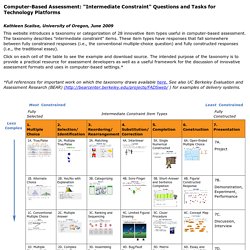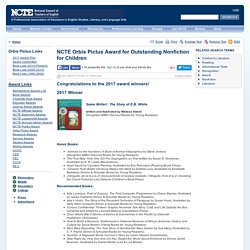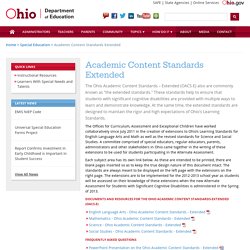

12 Things You Should Know to be Computer/Tech Literate. Kids.gov: The U.S. Government's Official Web Portal for Kids. What's New? Taxonomy Table. Computer-Based Assessment: "Intermediate Constraint" Questions and Tasks for Technology Platforms Kathleen Scalise, University of Oregon, June 2009 This website introduces a taxonomy or categorization of 28 innovative item types useful in computer-based assessment.

The taxonomy describes "intermediate constraint" items. These item types have responses that fall somewhere between fully constrained responses (i.e., the conventional multiple-choice question) and fully constructed responses (i.e., the traditional essay). Click on each cell of the table to see the example and download source. *Full references for important work on which the taxonomy draws availablehere.See also UC Berkeley Evaluation and Assessment Research (BEAR)( for examples of delivery systems.
Orbis Pictus Award for Outstanding Nonfiction for Children. Congratulations to the 2017 award winners!

2017 Winner Some Writer! : The Story of E.B. White written and illustrated by Melissa Sweet(Houghton Mifflin Harcourt Books for Young Readers) Honor Books:
How to Get Hesitant Teachers to Use Technology. In my consulting as well as administrative technology work, I am often asked the same questions by different schools and officials.

One of the most common is: “How do you get teachers who are hesitant or resistant to use technology?” I am keenly aware that many of my colleagues are not, for various reasons, gung ho about educational technology. And it’s interesting. Quite often, the teachers who are hesitant to adopt new technology are great — in fact, amazing — educators. They are frequently veterans and usually leaders in their academic field and within their institutions. In my role as tech advocate, I habitually find myself trying to coax these established educators to use new tools and incorporate new methodologies. 1. If you’re working with veteran educators, this is especially important.
Instead, try this: observe what they do in the classroom that’s made them successful and build out from there. 2. 3. Teachers respond better to other teachers who share their situation.
Content. Ohio Treasure Chest of Tech Resources. How Teachers Are Hacking Their Own Digital Textbooks. March’s issue of Wired Magazine included a fascinating interview* with Clayton Christensen, Business professor at Harvard University and author of several books, including The Innovator’s Dilemma and Disrupting Class: How Disruptive Innovations Will Change the Way the World Learns . Since these books were published, the world of education has seen an influx of technology with tablets leading the way. While it’s difficult to know exactly how many schools have deployed 1 to 1 initiatives, one thing remains certain: there were will be more schools with 1 to 1 technology disrupting the classroom tomorrow than there are today.
The disruptive device of choice these days seems to be the iPad. Perhaps you’ve seen one of the gazillion articles written about how iPads are disrupting the learning environment. The gist of the conversation usually highlights both positive and negative benefits to learning and inevitably reaches the question “when will iPads replace textbooks?” Which Camp Are You? I Teach Bay. OTES, SLO, FIP Crosswalk. #OHEdChat Archives. GetEdFunding. Leg Services Commission Analysis of Kasich funding bill. ODE One-Stop Data Site.
List of Form Assess Strategies. Three-Minute Video Intro to CCSS. CCSS Home. ODE Extended Standards. The Ohio Academic Content Standards – Extended (OACS-E) also are commonly known as "the extended standards.

" These standards help to ensure that students with significant cognitive disabilities are provided with multiple ways to learn and demonstrate knowledge. At the same time, the extended standards are designed to maintain the rigor and high expectations of Ohio’s Learning Standards. The Offices for Curriculum, Assessment and Exceptional Children have worked collaboratively since July 2011 in the creation of extensions to Ohio’s Learning Standards for English Language Arts and Math as well as the revised standards for Science and Social Studies.
A committee comprised of special educators, regular educators, parents, administrators and other stakeholders in Ohio came together in the writing of these extensions to be used for students participating in the Alternate Assessment. Each subject area has its own link below. Frequently Asked Questions Questions?